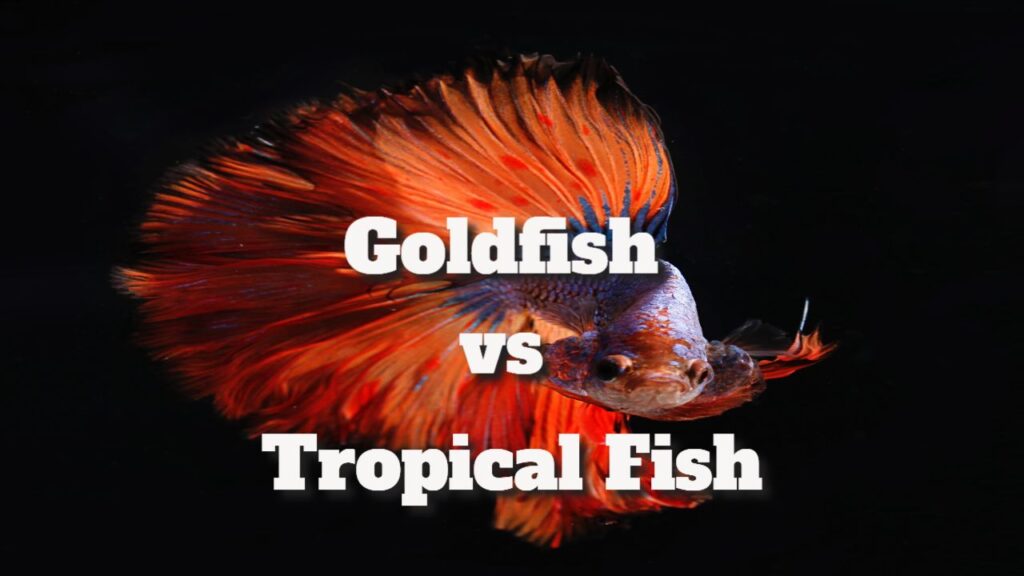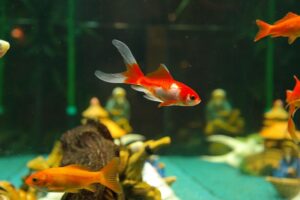Discover the Key Differences Between Goldfish and Tropical Fish for Your Aquarium
Keeping fish as pets is a popular hobby enjoyed by many across the globe. However, for those who are just starting their aquarium journey, choosing the right fish species can be quite challenging. Among the most favored choices are goldfish and tropical fish. Although they might appear similar at first glance, these two types of fish have significant differences that are essential to understand for successful fish keeping.
Goldfish are freshwater fish that originate from East Asia and are typically kept in cold-water aquariums. They are known for their resilience and can adapt to a variety of water conditions, making them an excellent choice for beginners. In contrast, tropical fish thrive in warm waters and require a heated aquarium to survive. They are generally more sensitive to changes in water quality and temperature, demanding greater care and attention from their owners.
When it comes to physical characteristics, goldfish typically exhibit a round shape with a short tail, while tropical fish come in a variety of shapes, sizes, and vibrant colors. Their behavior also differs significantly, highlighting the importance of understanding these distinctions when selecting the right species for your aquarium environment.
Understanding the Basic Requirements for Goldfish and Tropical Fish Care
This section delves into the fundamental needs of both goldfish and tropical fish, focusing on two critical aspects: tank size and environment, as well as water temperature and composition.
Optimal Tank Size and Environment for Healthy Fish
The size of your aquarium plays a pivotal role in the health and well-being of your fish. As a general guideline, a single goldfish requires a minimum of 20 liters of water, with an additional 10 liters for each subsequent goldfish. A useful rule of thumb is to allocate at least 1 liter of water for every centimeter of fish in your tank.
In addition to tank size, the surrounding environment is equally important. Tropical fish thrive in moderate water flow and benefit from plenty of hiding spots, while goldfish favor larger tanks with minimal water movement. Incorporating plants, rocks, and caves can create necessary shelters for the fish, and employing a quality filter will help maintain clean and healthy water conditions.
Essential Water Temperature and Composition for Fish Health
Goldfish are classified as cold-water fish and prefer water temperatures ranging from 18 to 24°C. In contrast, tropical fish thrive in warmer waters with optimal temperatures between 24 and 28 degrees Celsius. It is crucial to regularly monitor and adjust the water temperature to keep your fish comfortable and healthy.
When considering water composition, goldfish flourish in water with a pH range of 7.0-7.5 and a hardness of 100-150 ppm. Tropical fish, however, prefer slightly acidic water with a pH of 6.5-7.0 and a hardness between 100-200 ppm. Adhering to these fundamental guidelines can significantly enhance the living conditions for your goldfish or tropical fish, ensuring they thrive and bring joy to your aquarium.
Exploring Nutrition and Feeding Practices
Understanding Dietary Differences
Goldfish are classified as omnivores, meaning they consume both plant and animal-based diets. They possess a relatively simple digestive system and can thrive on a diet consisting of fish flakes or pellets. To maintain their health and happiness, it's essential to supplement their diet with fresh vegetables such as peas, spinach, and lettuce. Additionally, goldfish enjoy live or frozen food options like bloodworms and brine shrimp, which provide vital nutrients and variety to their meals.
Conversely, some tropical fish species are carnivorous, requiring a meat-based diet that may include prawns or other small fish.
Determining Feeding Frequency for Optimal Health
Goldfish have a slower metabolism and can go longer periods without food. Ideally, they should be fed once or twice a day, offering only as much as they can consume in a few minutes. Overfeeding can lead to health complications such as constipation and swim bladder disorders.
Depending on the specific tropical fish species, they may need to be fed two to three times daily, with smaller portions at each feeding. It is imperative to remove any uneaten food promptly, as it can quickly pollute the aquarium water and lead to health issues for the fish. Understanding the nutritional requirements and feeding habits of your fish is crucial for ensuring they receive the proper diet and stay healthy. By providing balanced nutrition and proper portioning, you can help your fish thrive in their aquatic environment.
Life Expectancy and Common Health Issues in Fish Care
Recognizing Common Health Issues
Identifying Parasites and Infections
Both goldfish and tropical fish can fall victim to various health issues, including parasites like ichthyosis, velvet, and gill worms. Symptoms of parasitic infections may include lethargy, loss of appetite, and visible white patches on the skin or fins of the fish.
Fungal infections can also affect both types of fish, often arising due to skin injuries or subpar water quality. Signs of fungal infections include white or gray patches on the skin or fins, as well as ragged or frayed fins.
Bacterial infections can occur in both goldfish and tropical fish, often linked to poor water quality, physical injuries, or stress. Common symptoms include redness, swelling, and the presence of ulcers on the skin or fins, necessitating prompt attention to maintain fish health.
Average Life Expectancy of Goldfish Versus Tropical Fish
The lifespan of both tropical fish and goldfish is influenced by several factors, including species, diet, water quality, and overall care. Goldfish generally enjoy a longer lifespan compared to tropical fish, with some species living up to 20 years when provided with optimal care. However, individual species and the level of care can significantly affect their longevity.
On the other hand, tropical fish typically have a shorter lifespan, with most species living around 3 to 5 years on average. Some specific species, such as angelfish and discus fish, can live for up to ten years or longer if properly cared for. Creating a healthy, stress-free environment is essential for promoting a longer, healthier life for your fish.
Comprehensive Maintenance and Care for Goldfish and Tropical Fish
Effective Cleaning Procedures for a Healthy Aquarium
To ensure your fish remain healthy and vibrant, it is vital to perform regular cleaning of their aquarium. The cleaning procedures differ for goldfish and tropical fish due to their varying needs. Daily removal of uneaten food and waste from the tank is crucial to prevent contamination and ensure clean water conditions for your fish.
Making it a habit to remove all food residues from the tank daily is essential for maintaining a healthy aquatic environment.
Understanding Behavioural Characteristics of Goldfish and Tropical Fish
Social Behavior Insights for Fish Owners
When it comes to social behavior, goldfish tend to exhibit more solitary tendencies compared to tropical fish. While some tropical fish species may prefer solitude, many thrive in groups and require the company of their conspecifics to feel secure and comfortable. In contrast, goldfish are generally content to live alone or with just a few companions.
Examining Activity Levels in Different Fish Species
Goldfish are known for their leisurely swimming style, often seen gently floating around their tank. This contrasts with tropical fish, which originate from warmer waters and must be more active to regulate their body temperature. The differences in behavioral characteristics between goldfish and tropical fish are significant, and it is essential to consider these factors when deciding which fish species to keep in your aquarium.
Your Questions Answered: FAQs About Goldfish and Tropical Fish Care
How Does Aquarium Setup Differ for Goldfish and Tropical Fish?
Goldfish and tropical fish necessitate distinct aquarium setups. Goldfish produce more waste, requiring a larger filter to maintain water quality. They are comfortable in cooler water temperatures, eliminating the need for a heater.
Can Goldfish Coexist with Tropical Fish in the Same Aquarium?
Goldfish can negatively impact water quality when housed alongside tropical fish due to their higher waste production and preference for cooler water temperatures.
What Are the Temperature Requirements for Goldfish Compared to Tropical Fish?
Goldfish thrive in cooler water temperatures ranging from 18 to 24°C, while tropical fish require warmer conditions between 24 and 28°C for optimal health.
Is Goldfish Care More or Less Demanding Than Tropical Fish Care?
While goldfish may require less attention in terms of heating, they necessitate more frequent water changes and a larger filter due to their space requirements and waste production.
How Do Nutritional Requirements Differ Between Goldfish and Tropical Fish?
Goldfish and tropical fish have distinct dietary needs. Goldfish are omnivorous, needing a diet rich in plant matter such as flakes, pellets, and vegetables. In contrast, tropical fish have a more varied diet, requiring a mix of flakes, pellets, frozen or live foods, and plant-based options.
Is It Viable for Goldfish and Tropical Fish to Live Together?
Goldfish can compromise water quality for tropical fish due to their varying requirements concerning water temperatures, space, and waste production, making cohabitation challenging.
The post Discover the Key Differences Between Goldfish and Tropical Fish for Your Aquarium appeared first on Unity Pets.
The post Discover the Key Differences Between Goldfish and Tropical Fish for Your Aquarium appeared first on https://gqcentral.co.uk
The Article Discover the Key Differences Between Goldfish and Tropical Fish for Your Aquarium First Appeared ON
: https://ad4sc.com
The Article Discover the Key Differences Between Goldfish and Tropical Fish for Your Aquarium was found on https://limitsofstrategy.com/





This article does a wonderful job of highlighting the key distinctions between goldfish and tropical fish, which are crucial for new aquarists to consider. I’ve found that choosing the right species can set the tone for the entire aquarium hobby experience.
You make a great point about how choosing the right species can really set the tone for an aquarium. It’s interesting how goldfish and tropical fish can not only differ in care requirements but also in the overall atmosphere they create in an aquarium. Goldfish often bring that nostalgic vibe, while tropical fish can offer so much variety in terms of color and behavior.
Your exploration of the differences between goldfish and tropical fish really resonates with my experience as an aquarium hobbyist. When I first ventured into this pastime, I was drawn to the vibrant colors and dynamic behaviors of tropical fish. However, I quickly learned that they come with a unique set of challenges that require dedicated attention to detail, especially concerning water conditions and temperature regulation.
It’s great to hear about your journey as an aquarium hobbyist and how it evolved over time. The vibrant colors of tropical fish really do draw you in, don’t they? It’s almost like bringing a piece of the ocean right into your living room. But, as you mentioned, with that beauty comes a lot of responsibility.
You’re so right about the colors of tropical fish—they really can transform a space and create such a calming atmosphere. It’s fascinating how observing them swim can even reduce stress levels; I’ve read studies that highlight how aquariums can benefit mental well-being.
This exploration of goldfish versus tropical fish opens up a rich dialogue about the intricacies of aquarium keeping. As a hobbyist myself, I can relate to the initial challenges of making that crucial decision about which species to start with. There’s something profoundly rewarding about nurturing a living ecosystem in your home, and understanding the distinct needs of different fish species is a foundational step in that journey.
Your experience really highlights the journey many of us go through when diving into the world of aquarium keeping. Choosing the right fish sets the tone for everything that comes after. I remember my own first few weeks, filled with excitement and some unexpected bumps along the way.
Your post highlights some essential distinctions between goldfish and tropical fish, especially for novice aquarium enthusiasts. I’ve found that the environmental requirements of these fish species can significantly impact not only their health but also the overall enjoyment of maintaining the aquarium.
You’ve raised such an important point about the impact of environmental conditions on fish health and overall aquarium enjoyment. It’s fascinating how the subtle differences in care can really shape your experience as an aquarium keeper. When it comes to goldfish and tropical fish, understanding their natural habitats helps us recreate environments that align closely with their needs.
What a fascinating dive into the aquatic world! As someone who’s definitely made a few rookie mistakes (like assuming my goldfish could use a little warm spa treatment), I really appreciate the distinctions you’re drawing between goldfish and tropical fish.
I can definitely relate to making those rookie mistakes; it’s all part of the learning curve when diving into the aquatic world. I remember reading about someone who gave their betta fish a ‘bubble bath’ because they thought it looked like fun. It’s interesting to see how well-intentioned actions can sometimes lead to misunderstandings about our pets’ needs.
I really appreciate how you broke down the differences between goldfish and tropical fish—it’s such a crucial aspect for beginners to grasp! I’ve dabbled in both types and can definitely relate to the varying care requirements.
I found this topic on goldfish versus tropical fish really intriguing! It’s interesting how these two types of fish can represent such different approaches to aquarium keeping. When I first started with my own aquarium, I opted for goldfish simply because of their hardiness and charm. I remember being captivated by the way they swam around, and I enjoyed watching them interact with their environment. However, I quickly learned that although goldfish are often seen as the “easy” option, they still require proper care, such as regular tank maintenance and appropriate feeding. It was a real eye-opener to realize that the misconception of them being low-maintenance can lead to overestimating one’s ability to care for them!
It’s great to hear about your experience with goldfish! They truly do have a unique charm that can captivate any aquarist, new or seasoned. What I find fascinating is how many people start with goldfish under the impression that they’re a ‘set it and forget it’ type of pet. Your realization about their actual care needs is a key point that many overlook.
Your breakdown of the differences between goldfish and tropical fish is quite informative, but it leads me to wonder about the implications of these differences for long-term fish keeping. While goldfish are marketed as resilient, I’ve often found that their longevity can hinge on trade-offs—like a smaller tank that may not support their growth over time. Conversely, tropical fish, though demanding, offer a vibrant diversity that can turn an aquarium into a miniature ecosystem when balanced correctly.
Your insights into the differences between goldfish and tropical fish are quite valuable for new aquarium enthusiasts. I remember when I first started my aquarium journey; I chose goldfish without fully understanding their needs and how distinct they are from tropical species. The adaptability of goldfish indeed makes them appealing, but many beginners overlook the long-term commitment they represent, especially when considering their potential size and lifespan.